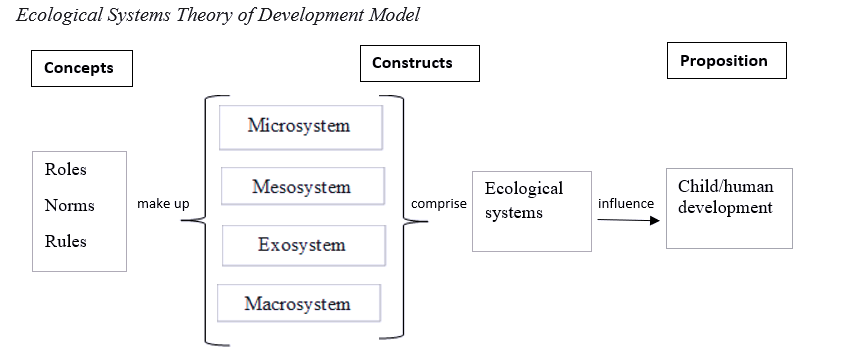4.2 Ecological Systems Theory
An Introduction to the Ecological Model in Public Health
Ecological Systems Theory (EST), also known as human ecology, is an ecological/ system framework developed in 1979 by Urie Bronfenbrenner (Harkonen, 2007). Harkonen notes that this theory was influenced by Vygotsky’s socio-cultural theory and Lewin’s behaviorism theory. Bronfenbrenner’s research focused on the impact of social interaction on child development. Bronfenbrenner believed that a person’s development was influenced by everything in the surrounding environment and social interactions within it. EST emphasizes that children are shaped by their interaction with others and the context. The theory has four complex layers called systems, commonly used in research. At first, ecological theory was most used in psychological research; however, several studies have used it in other fields such as law, business, management, teaching and learning, and education.

Previous Studies
EST has been used in many different fields, however, commonly, it is used in health and psychology, especially in child development (e.g., Heather, 2016; Esolage, 2014; Matinello, 2020). For instance, Walker et al. (2019) used an EST framework to examine risk factors for overweight and obese children with disabilities. The study focused on how layers of an ecological system or environment can negatively affect children with special needs in terms of weight and obesity. They found that microsystem such as school, family home, and extracurricular activities can impact overall health through physical activities and food selectivity. Furthermore, the second layer, mesosystem (e.g., family dynamic and parental employment), also can lead to an increase in children’s weight because of a lack of money to buy nutritious food. In addition, children may be socially isolated and excluded in ways that cause stress, and their parents might use food to reinforce or comfort them. The third layer the study adopted was the macrosystem. For example, some cultures discriminate against children with disabilities so that they face more difficulty gaining access to health services.
In the field of language teaching, Mohammadabadi et al. (2019) researched factors influencing language teaching cognition. They used an ecological framework to explore the factors influencing language teachers at different levels. They adopted the four systems from Bronfenbrenner’s theory for studying the issue. This study found that the ecological systems affect language teaching. For example, the microsystem included a direct influence on teachers’ immediate surroundings, such as facilities, emotional mood, teachers’ job satisfaction, and linguistic proficiency. The mesosystem defined interconnections between teachers’ collaboration and their prior learning experience. The exosystem included the teaching program and curriculum and teachers’ evaluation criteria, while the macrosystem addressed the government’s rules, culture, and religious beliefs. In other words, researchers use EST to guide the design of their studies and to interpret the results.
Model of EST

Concepts, Constructs, and Propositions
The four systems that Brofenbrenner proposed are constructed by roles, norm and rules (see Figure 4.2.2). The first system is the microsystem. The microsystem as the innermost system is defined as the most proximal setting in which a person is situated or where children directly interact face to face with others. This system includes the home and child-care (e.g., parents, teacher, and peers). The second is the mesosystem. The mesosystem is an interaction among two or more microsystems where children actively participate in a new setting; for instance, the relationship between the family and school teachers. The third is the exosystem. This system does not directly influence children, but it can affect the microsystem. The effect is indirect. However, it still may positively or negatively affect children’s development through the parent’s workplace, the neighborhood, and financial difficulties. The outermost system is the macrosystem. Like the exosystem, the macrosystem does not influence children directly; however, it can impact all the systems such as economic, social, and political systems. The influence of the macrosystem is reflected in how other systems, such as family, schools, and the neighborhood, function (Kitchen et al., 2019). These four systems construct the EST which considers their influences on child or human development.
Bronfenbrenner (cited in Harkonen, 2007) noted that those environments (contexts) could influence children’s development constructively or destructively. As the proposition, the system influences children or human development in many aspects, such as how they act and interact, their physical maturity, personal characteristics, health and growth, behavior, leadership skills, and others. At the end of the ecological system improvement phase, Bronfenbrenner also added time (the chronosystem) that focuses on socio-history or events associated with time (Schunk, 2016). In summary, the views of this ecological paradigm is that environment, social interaction, and time play essential roles in human development.
Using the Model
There are many possible ways to use the model as teachers and parents. For teaching purposes, teachers can use the model to create personalized learning experiences for students. The systems support teachers and school administrators to develop school environments that are suitable to students’ needs, characteristics, culture, and family background (Taylor & Gebre, 2016). Because the model focuses on the context (Schunk, 2016), teachers and school administration can use the model to increase students’ academic achievement and education attainment by involving parents and observing other contextual factors (e.g., students’ peers, extra-curricular activities, and neighbor) that may help or inhibit their learning.
Furthermore, the EST model can support parents to educate and guide their children. It can prompt parents to assist their children in choosing their friends and finding good neighborhoods and schools. Additionally, they can build close connections to teachers, so they know their children’ skills and abilities. By involving themselves in schools, parents can positively influence their children’s educational context (Hoover & Sandler, 1997).
For research purposes, researchers can test and modify or refine the EST proposition, or they can find additional ways to measure it. Researchers also can develop questionnaires from the components or concepts and construct of EST. Additionally, the four levels of EST can be used by researchers to frame qualitative, quantitative, and mixed research (Onwuegbuzie, et.al., 2013).
Conclusion
We all begin as blank puzzle pieces, who we become is influenced by those around us, such as: family, parents, teachers, people, places, things, community, society, political systems, education and environment.

At first, EST was used in children’s development studies to describe their development in their early stages influenced by the person, social, and political systems. Currently, EST is broadly applied in many fields. Schools or educational institutions can use EST to improve students’ achievement and well-being. Interaction between the family, parents, teachers, community, and political system will determine students’ development outcomes.
For More Information – Videos:
References
- Figure 4.2.1 – Wordart created by Denise Halsey
- Figure 4.2.2 – Model of EST – Roe, J. E. A. M. (n.d.). Ecological Systems Theory – Theoretical Models for Teaching and Research. https://opentext.wsu.edu/theoreticalmodelsforteachingandresearch/chapter/ecological-systems-theory/
- Figure 4.2.3 – Photo by Unsplash License
- SocioEcological Theory of Addiction. (2016, March 11). [Video]. YouTube. https://www.youtube.com/watch?v=RoSjNZbTixk
- Doc Snipes. (2016, March 11). SocioEcological Theory of Addiction [Video]. YouTube. https://www.youtube.com/watch?v=RoSjNZbTixk
- Esolage, D. L. (2014). Ecological theory: Preventing youth bullying, aggression, and victimization. Theory into Practice. 53, 257–264.
- Harkonen, U. (2007, October 17). The Bronfenbenner ecological system theory of human development. Scientific Articles of V International Conference PERSON.COLOR.NATURE.MUSIC, Daugavpils University, Latvia, 1 – 17.
- Heather, M.F. (2016). An ecological approach to understanding delinquency of youth in foster care. Deviant Behavior, 37(2), 139 – 150.
- Hoover-Dempsey, K. V., & Sandler, H. M. (1997). Why do parents become involved in their children’s education? Review of Educational Research, 67(1), 3–42. https://doi.org/10.3102/00346543067001003
- Kitchen, J. A, (list all authors in reference list) (2019). Advancing the use of ecological system theory in college students research: The ecological system interview tool. Journal of College Students Development, 60 (4), 381-400.
- Martinello, E. (2020). Applying the ecological system theory to better understanding and prevent child sexual abuse. Sexuality and Culture, 24, 326-344
- Mohammadabadi, A., Ketabi, S., & Nejadansari, D. (2019). Factor influencing language teaching cognition. Studies in Second Language Learning and Teaching. 9(4), 657 – 680.
- Onwuegbuzie, A.J., Collins, K.M.T., & Frels, R.K. (2013). Foreword. International Journal of Multiple Research Approaches, 7(1), 2-8.
- Schunk, D. H. (2016). Learning theory: An educational perspective. Pearson.
- Taylor, R. D., & Gebre, A. (2016). Teacher–student relationships and personalized learning: Implications of person and contextual variables. In M. Murphy, S. Redding, & J. Twyman (Eds.), Handbook on personalized learning for states, districts, and schools (pp. 205–220). Temple University, Center on Innovations in Learning.
- Walker, M., Nixon, S., Haines. J., & McPherson, A.C. (2019). Examining risk factors for overweight and obesity in children with disabilities: A commentary on Bronfenbrenner’s ecological system framework. Developmental Neurorehabilitation, 22(5), 359 – 364.
- Ecological Systems Theory by Joy Egbert and Mary Roe is licensed under a Creative Commons Attribution-NonCommercial 4.0 International License, except where otherwise noted.

